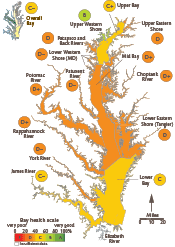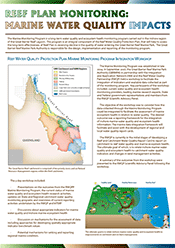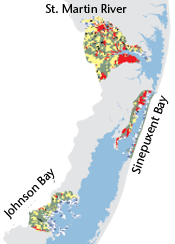2007 Chesapeake Bay Report Card
 IAN and EcoCheck (a NOAA-UMCES partnership) recently released the 2007 Chesapeake Bay Report Card. The report card provides a scientifically robust - and geographically detailed - annual assessment of Chesapeake Bay health. This report card rates 15 reporting regions of the Bay using six indicators that are combined into a single overarching index of bay health. The Bay Health Index is defined as progress of the six indicators towards established, scientifically derived ecological thresholds or goals. The report card was produced in partnership with many Chesapeake Bay scientific and management organizations and individuals. The report card and supporting material can be downloaded from the EcoCheck website.
IAN and EcoCheck (a NOAA-UMCES partnership) recently released the 2007 Chesapeake Bay Report Card. The report card provides a scientifically robust - and geographically detailed - annual assessment of Chesapeake Bay health. This report card rates 15 reporting regions of the Bay using six indicators that are combined into a single overarching index of bay health. The Bay Health Index is defined as progress of the six indicators towards established, scientifically derived ecological thresholds or goals. The report card was produced in partnership with many Chesapeake Bay scientific and management organizations and individuals. The report card and supporting material can be downloaded from the EcoCheck website.
Reef Plan Monitoring: Marine Water Quality Impacts
 The Marine Monitoring Program is a long-term water quality and ecosystem heath monitoring program carried out in the inshore region of the Great Barrier Reef Lagoon. The program is an integral component of the Reef Water Quality Protection Plan, that will help to assess the long-term effectiveness of Reef Plan in reversing decline in the quality of water entering the Great Barrier Reef Marine Park. The Great Barrier Reef Marine Park Authority (GBRMPA) is responsible for the design, implementation and reporting of the monitoring program. This newsletter summarizes the outcomes from the Marine Integration Workshop, facilitated by Bill Dennison (IAN), Ben Longstaff (EcoCheck), and Jane Thomas (IAN).
The Marine Monitoring Program is a long-term water quality and ecosystem heath monitoring program carried out in the inshore region of the Great Barrier Reef Lagoon. The program is an integral component of the Reef Water Quality Protection Plan, that will help to assess the long-term effectiveness of Reef Plan in reversing decline in the quality of water entering the Great Barrier Reef Marine Park. The Great Barrier Reef Marine Park Authority (GBRMPA) is responsible for the design, implementation and reporting of the monitoring program. This newsletter summarizes the outcomes from the Marine Integration Workshop, facilitated by Bill Dennison (IAN), Ben Longstaff (EcoCheck), and Jane Thomas (IAN).
Reporting fine scale water quality and nitrogen source patterns related to land use in Maryland's Coastal Bays
 Following prior studies in Maryland's Coastal Bays, graduate students Ben Fertig and Kris Beckert, and their advisors, Bill Dennison, Tim Carruthers, Judy O'Neil, and Tom Fisher conducted a more detailed assessment of nitrogen sources and linkages with land use. Focusing on St. Martin River, Johnson Bay, and Sinepuxent Bay, oyster bioindicators and a suite of water quality measurements suggest that these coastal bays are vulnerable to nitrogen loads from various land uses. Trends indicated degraded water quality, high turbidity, increasing total nitrogen and phosphorus concentrations, high natural isotope abundance (δ15N), and low dissolved oxygen. While terrestrial anthropogenic pressures vary within subwatersheds, water quality in these coastal bays is also influenced by differences in flushing and nutrient cycling abilities.
Following prior studies in Maryland's Coastal Bays, graduate students Ben Fertig and Kris Beckert, and their advisors, Bill Dennison, Tim Carruthers, Judy O'Neil, and Tom Fisher conducted a more detailed assessment of nitrogen sources and linkages with land use. Focusing on St. Martin River, Johnson Bay, and Sinepuxent Bay, oyster bioindicators and a suite of water quality measurements suggest that these coastal bays are vulnerable to nitrogen loads from various land uses. Trends indicated degraded water quality, high turbidity, increasing total nitrogen and phosphorus concentrations, high natural isotope abundance (δ15N), and low dissolved oxygen. While terrestrial anthropogenic pressures vary within subwatersheds, water quality in these coastal bays is also influenced by differences in flushing and nutrient cycling abilities.
The charisma of coastal ecosystems: addressing the imbalance
 This article, recently published in Estuaries and Coasts 31(2): 233-238, assesses the relative research effort, as well as relative media reporting of this research effort, for the major coastal ecosystems. Although seagrass meadows support equivalent ecosystem services to coral, mangrove and salt marsh habitats - they recieve less research effort and that effort is proportionately reported in the media far less. Effective science communication to better educate the public and students is seen as essential to raise awareness of seagrass habitats and thus preserve their valuable ecosystem services.
This article, recently published in Estuaries and Coasts 31(2): 233-238, assesses the relative research effort, as well as relative media reporting of this research effort, for the major coastal ecosystems. Although seagrass meadows support equivalent ecosystem services to coral, mangrove and salt marsh habitats - they recieve less research effort and that effort is proportionately reported in the media far less. Effective science communication to better educate the public and students is seen as essential to raise awareness of seagrass habitats and thus preserve their valuable ecosystem services.

